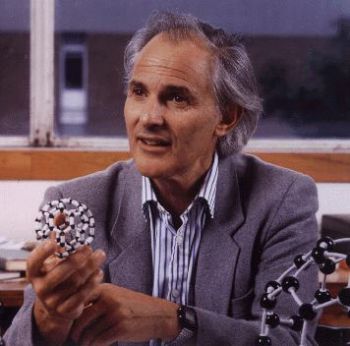Sussex Nobel winner's molecule listed in top 10 discoveries
By: James Hakner
Last updated: Wednesday, 16 June 2010

Professor Harry Kroto holds a model of a 'buckyball', a carbon molecule
Nobel Prize-winning research carried out by Professor Sir Harry Kroto at the University of Sussex has been named by fellow academics as one of the ten most important discoveries made by their peers at UK universities in the past 60 years.
A poll of UK academics - carried out to mark Universities Week from 14-20 June - placed Professor Kroto's 1985 discovery of the microscopic 'footballs' known as "buckyballs" tenth in a list topped by the discovery of the structure of DNA (unveiled in 1953).
Professor Kroto, who was invited to announce the poll results, said: "It surely comes as no surprise that DNA has come out top. It is not only pre-eminently important to understanding almost every fundamental aspect of life itself but it is also so beautiful and at the same time so simple in revealing how genetic characteristics are transmitted.
"Despite the fact that the discovery is over 50 years old, this finding is instrumental in every element of our lives and the basis of our understanding about life on Earth.
Other findings in the top ten included the first computer, stem cell research, the contraceptive pill and the Internet.
Professor Kroto said: "This list demonstrates the outstanding level of achievement of research scientists in UK universities and their impact on our everyday lives. Even in another 60 years I hope that this list will inspire people to appreciate the contribution to human knowledge and well-being of researchers in our universities. We have some of the world's best researchers and must continue to value their work if we are to advance our understanding of the world and of what humans are capable."
Professor Kroto and his US collaborators Robert Curl and Richard Smalley were jointly awarded the Nobel Prize in Chemistry in 1996 for the discovery of a new form of carbon. The C60 molecule was created from 60 carbon atoms arranged in the same structure as a football.
The discovery of a whole family of carbon-cage molecules soon followed, collectively dubbed "fullerenes" after their similarity to the geodesic domes designed by the late Richard Buckminster Fuller. Fullerenes include football and rugby-ball shapes and tubes of carbon, called nanotubes, which sparked the nanotech revolution.
Professor Laurence Pearl, Head of the School of Life Sciences, welcomed the inclusion of Professor Kroto's work in the top ten list.
He said: "The discoveries cited in the list are pinnacles on the mountains of exciting and innovative research work carried out in universities and research institutes by thousands of scientists.
"All these major successes came from asking basic questions and it would have been almost impossible to have predicted the significance of the outcomes, when the scientists responsible started to address their particular problem.
"We will only keep this level of achievement, and the economic prosperity it drives, if we continue to take chances and provide the financial support for curiosity-driven research in our universities."

